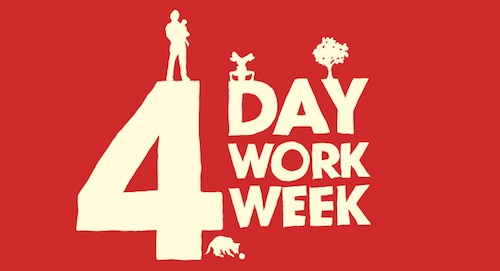People already do this — the video above is an example, and there are pockets of big companies (like ESPN) where people can get 4 x 10 shifts as opposed to the standard 5 x 8 shift model for office/white-collar jobs. Some legit people — Forbes, for example, and CNN — are on board with the idea. Let’s run down a couple of things associated with this idea.
1. We know, pretty conclusively, that the idea of employee engagement is way down over the past decade or so.
2. A lot of people end up staying at the office a little bit later here and there, whether that’s for “avoiding rush hour” or “finishing projects” or whatever else. Remember, being busy is in some ways the currency of the modern era.
3. Standard, long-held argument: when you’re primarily at work, you tend to do your errands — i.e. dry cleaning, shopping — on the weekends, which is when everyone else is also doing them.
4. The work week is probably too long at 40 hours right now if you actively consider that we’re in a knowledge-based economy presently, as opposed to a strictly industrial one.
So here’s what happens if you do this: you create a situation where everyone gets a “regular day” (weekday) off to tend to errands/responsibilities. You create a stronger work-life balance. And assuming the “off-day” is generally Friday (it would have to shift among employees in order to work with the companies who are working a full five days), then … every weekend of your life in this job is now a three-day weekend. That’s pretty sweet, right? That motivation alone could help increase engagement.
Think about this, also: it’s 3:46pm, on a Friday, on the east coast as I write this. How much tangible work do you think is getting done in those offices, or has for the last 1-2 hours? Probably not a ton. Friday is a check-out day for a lot of people anyway — the agendas and tenor are different — and if you don’t believe that, consider that it’s almost always the day that gets chopped in half for “summer Fridays” or “beer o’clock.” If you condensed the work, it might be more effective and engaged as a result.
Obviously, the flip side is the idea that competitors in your industry might be working 40-hour/weeks, which means 60-hour/weeks for the Type-A among those competitors, which means you might be falling behind. That’s the basic way to look at it. The other way to look at would be “Well, what if I found myself better people — people with a real focus on time management — who could work well on this schedule because they know the inherent benefits of the system?” That would be a kind of next level approach to this issue: solve it by trying to get better people.
Health-insurance wise (because that’s always an elephant in any business decision room), you could do 4 x 10 (40 hours a week) and keep coverage for those people, or let people go 4 x 8 (32 hours a week) and determine the coverage level to be 32-35 hours. I’ve seen companies cover above 28 hours/week, so this is somewhat flexible within management discussions.
If you want people to be engaged — if you don’t want them to leave, and you want them bound to your org in some way beyond compensation/contract — then consider giving them back some of their life and trusting them that they can accomplish the same goals in 4 days that others do in 5 days. Trust, communication, and work-life balance. Aren’t those three wonderful things in building an organizational culture?

Awesome post.